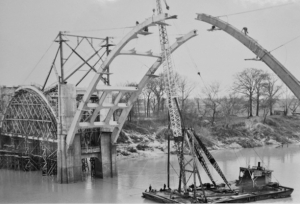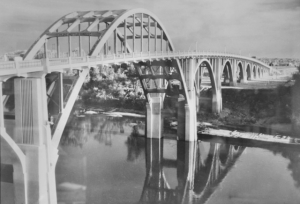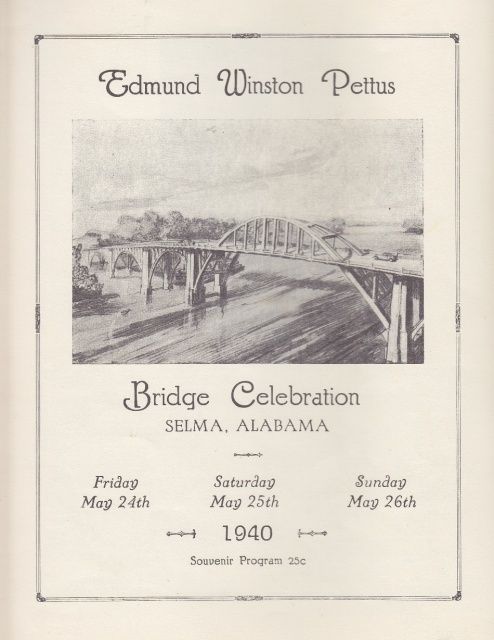A bridge to history
By Phyllis Moore
Published in News on March 15, 2015 1:50 AM

News-Argus/PHYLLIS MOORE
Sam Hunter, president of T.A. Loving Co., describes some of the logistics that went into building the Edmund Pettus Bridge in Selma, Ala. The Goldsboro company has pictures of the bridge in various stages of completion.

Submitted photo
This photo of the Edmund Pettus Bridge in Selma under construction before being completed in 1940, adorns a wall in the lobby of T.A. Loving Co.

Submitted photo
The four-lane Edmund Pettus Bridge, in Selma, Alabama, built in 1940 by T.A. Loving Company of Goldsboro, has become renowned over the years for its civil rights connections, as well as the recent Oscar-nominated movie "Selma."
One of the most celebrated and historic bridges of the Civil Rights Movement -- the Edmund Pettus Bridge in Selma, Alabama -- has ties to Goldsboro.
By now, most have seen images of the renowned site, featured in the Oscar-nominated film "Selma" and the focal point of President Obama's visit last weekend to commemorate the 50th anniversary of "Bloody Sunday," a civil rights march where protesters were beaten, trampled and tear-gassed by police on March 7, 1965.
The attack was well-publicized after peaceful civil rights demonstrators attempted the 54-mile march to the Alabama state capital of Montgomery. The bridge was later declared a national historic landmark on March 11, 2013.
But a lesser-known fact is that it was built by T.A. Loving Company.
Sam Hunter is president of the Goldsboro-based company founded 90 years ago by T.A. Loving and later joined by his brother, John Loving, who became vice president and director of the company's bridge division. The brothers have since passed away.
Now known more as a building contractor, in the early days it was a "bridge company," Hunter said. The company can take credit for such structures in North Carolina as the bridge at Nags Head and the Currituck Sound Bridge and several prominent bridges in Miami, St. Augustine and Daytona, Florida. And, of course, the now-infamous Selma bridge.
"My father-in-law was actually the person that built it or was in charge of our bridge work," Hunter said. "They had quite a dedication when they finished that project down there. It was quite a project to have been built back in the '40s by a little contractor in Goldsboro."
Hunter said company representatives actually had to travel down to Alabama to bid on the project with the Department of Transportation.
And it proved to be quite an extensive job, taking more than a year to complete.
"It probably started in 1938," he said. "They dedicated the bridge May 24, 1940."
John Loving was in charge of the contract, accompanied by at least two supervisors, John Wall and Alfred Womble, Hunter said.
According to a souvenir program from the three-day dedication celebration, the former "horse-and-buggy" bridge that carries U.S. Route 80 across the Alabama River was 1,248 feet long and 55 feet wide.
The job of T.A. Loving Company was to erect a 240-foot steel arch across the main channel, including 10 concrete arch spans varying in length from 41 feet to 154 feet.
The specifications presented some challenges, Hunter said, recalling stories passed down from his predecessors.
"You can't really see it all from the photos that make the front page," he said, pointing to one of the two black and white photos taken during and after construction, that adorn a wall of his company's lobby. "There's a series of arches made out of concrete.
"(My father-in-law) told the story. They showed up down there, he goes to a local sawmill, tells them to cut trees, used for 'false work,' then you pour those concrete arches and you build the bridge off those concrete arches."
Another obstacle, he said, was lacking equipment for some of the task.
"We didn't even have a crane that could reach the top of that arch," he said, explaining that they somehow fashioned a make-shift "derrick" and "just kept making the boom longer and mounted it on the barge. That's how they built the center arch."
At the time of completion, Hunter said, the buzz was that the structure was the "finest bridge between Savannah and San Diego."
The bridge was named for Edmund Winston Pettus, a former Confederate brigadier general, Democratic U.S. senator and Grand Dragon of the Alabama Ku Klux Klan. According to the dedication ceremony program, "the road that used to connect us with Montgomery has become a highway that connects us with all America."
But 25 years later, its infamy would send ripple effects across the nation that continue today.
Citizens denied the right to vote formed a plan to gather peacefully and march from Selma to Montgomery to make a plea for help. On March 7, 1965, roughly 600 unarmed people began the trek from downtown Selma. As they crossed the bridge, a fight broke out with law enforcement stationed there. News spread quickly and then-President Lyndon B. Johnson addressed the nation, calling for unity.
"Their cause must be our cause," he said.
Two weeks later, on March 21, Dr. Martin Luther King Jr. went to Selma and successfully led 4,000 people across the Pettus Bridge and on toward the capital.
The significance of the bridge, then and now, has never been lost on those at T.A. Loving, Hunter said.
"It's always been, for me, an important thing for our company," he said. "It's such an important bridge now and a landmark. Just to know that although it's in Alabama, you've got a company in Goldsboro, North Carolina that built it. (There are) people that live here that had fathers that worked on it.
"It's 54 miles from Selma to Montgomery. They could have had a run-in that day anywhere but it happened on that bridge -- the bridge constructed by the T.A. Loving Company of Goldsboro, North Carolina."

